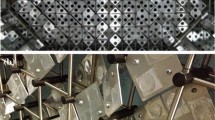Abstract
Thek-kl-model of turbulence based on the equation of second two-point moments (pointsA andB) of the fluctuating velocity field is presented. The second and third moments entering into this equation are expressed using polynomials whose terms are products of the tensor components characterizing a given turbulent motion and scalar functions of the distanceAB. ForAB=0 the equation obtained gives thek-turbulence energy balance equation and, on being integrated overAB from 0 to ∞, the transport equation for thekl-quantity (l is the integral turbulence scale). The model is used for calculating mixing layers, plane and circular jets, the wake behind a cylinder, tube and channel flows, and the boundary layer on a plate. The results of all the calculations agree well with the experimental data for a single set of empirical coefficients.
Similar content being viewed by others
References
B. E. Launder and D. B. Spalding, “The numerical computation of turbulent flows,”Comput. Math. Appl. Mech. and Eng.,2, 269 (1974).
W. P. Jones and B. E. Launder, “The calculation of low-Reynolds-number phenomena with a 2-equation model of turbulence,”Int. J. Heat and Mass Transfer,16, 1119 (1973).
K. Khan'yalich and B. E. Launder, “Allowance for irrotational stresses in the turbulent energy dissipation equation,”Teor. Osn. Inzh. Rasch. 102, No. 1, 149 (1980).
S. B. Pope, “An explanation of the turbulent round-jet/plane-jet anomaly,”AIAA J.,16, 279 (1978).
J. Rotta, “Statistische Theorie nichthomogener Turbulenz,”Z. Phys.,131, 51 (1951).
G. S. Glushko, “A differential equation for the turbulence scale and a calculation of the turbulent boundary layer on a plane plate,” in:Turbulent Flows [in Russian], Nauka, Moscow (1970), p. 37.
V. M. Ievlev,Turbulent Motion of High-Temperature Continua [in Russian], Nauka, Moscow (1975).
W. Rodi and D. B. Spalding, “A two-parameter model of turbulence and its application to free jet,”Wärme-und Stoffūbertragung,3, No. 2, 85 (1970).
K. H. Ng and D. B. Spalding, “Predictions of 2-dimensional boundary layers on smooth walls with a 2-equation model of turbulence,”Int. J. Heat and Mass Transfer,19, 1161 (1976).
H. Volmers and J. C. Rotta, “Similar solutions of the mean velocity, turbulent energy and length scale equation,”AIAA J.,15, 714 (1977).
D. Jeandel, J. Brison, and J. Mathieu, “Modeling methods in physical and spectral space,”Phys. Fluids,21, 169, (1978).
V. W. Nee and L. S. G. Kovaznay, “Simple phenomenological theory of turbulent shear flows,”Phys. Fluids,12, 473, (1969).
A. N. Sekundov, “Application of a differential equation for the turbulent viscosity to an analysis of plane non-self-similar flows,”Izv. Akad. Nauk SSSR, Mekh. Zhidk. Gaza, No. 5, 114, (1971).
A. N. Kolmogorov, “Equations of turbulent motion of an incompressible fluid,”Izv. Akad. Nauk SSSR, Ser. Phiz.,6, 56 (1942).
P. G. Saffman, “A model for inhomogeneous turbulent flow,”Proc. Roy. Soc. Ser. A,317, No. 1530, 417 (1970).
D. B. Spalding, “Concentration fluctuations in a round turbulent free jet,”Chem. Eng. Sci.,26, 95 (1971).
P. G. Saffman and D. C. Wilcox, “Turbulence-model predictions for turbulent boundary layers,”AIAA J.,12, 541 (1974).
V. G. Lushchik, A. A. Pavel'ev, and A. E. Yakubenko, “Three-parameter model of translation turbulence,”Izv. Akad. Nauk SSSR, Mekh. Zhidk. Gaza, No. 3, 13, (1978).
V. G. Lushchik, A. A. Pavel'ev, and A. E. Yakubenko, “Three-parametric model of turbulence: calculation of heat transfer,”Izv. Akad. Nauk SSSR, Mekh. Zhidk. Gaza, No. 2, 40, (1986).
R. Shistel, “Sur le concept d'échelles multiples en modelisation des écoulements turbulents,”J. Mec. Theor. Appl.,2, 417 (1983).
K. Khan'yalich, B. E. Launder, and P. Shistel, “The multiple time scale concept in modeling of turbulent transfer,” in:Turbulent Translation Flows, vol. 2 [in Russian], Mashinostroenie, Moscow (1983), p. 42.
N. I. Akatnov, “An equation for turbulence scale in the case of arbitrary three-dimensional average motion of a fluid,” in: Abstracts of Proceedings of Sixth All-Union Congress on Theoretical and Applied Mechanics, Tashkent, 24–30 September, 1986 [in Russian], Tashkent (1986).
I. S. Khintse,Turbulence [in Russian], Fizmatgiz, Moscow (1963).
G. K. Batchelor,The Theory of Homogeneous Turbulence, Cambridge (1953).
N. I. Akatnov, “Two-scale semiempirical theory of turbulent boundary layers and jets,”Izv. Akad. Nauk SSSR, Mekh. Zhidk. Gaza, No. 6, 17, (1982).
H. W. Liepmann and J. Laufer, “Investigations of free turbulent mixing,”NACA, Tech. Notes, No. 1257 (1947).
I. Wygnanski and H. E. Fiedler, “The two-dimensional mixing region,”J. Fluid Mech.,41, 327 (1970).
R. P. Patel, “An experimental study of a plane mixing layer,”AIAA J.,11, 67 (1973).
L. J. Bradbury, “The structure of a self-preserving turbulent plane jet,”J. Fluid Mech.,23, 31 (1965).
G. Heskestad, “Hot-wire measurements in a plane turbulent jet,”J. Appl. Mech.,32, 721 (1965).
E. Gutmark and I. Wygnanski, “The planar turbulent jet,”J. Fluid Mech.,32, 465 (1976).
I. Wygnanski and H. E. Fiedler, “Some measurements in the self-preserving jet,”J. Fluid Mech.,38, 577 (1969).
A. A. Townsend,Structure of Turbulent Shear Flow, Cambridge University Press (1956).
G. Comte-Bellot,Turbulent Flow in a Channel with Parallel Walls [Russian translation], Mir, Moscow (1968).
J. Laufer, “Investigation of turbulent flow in a two-dimensional channel,” NACA Rep., No. 1053 (1952).
J. Clark, “A study of incompressible turbulent boundary layers in channel flow,”J. Basic Eng.,90, 455 (1968).
L. I. Sedov,Similarity and Dimensional Methods in Mechanics, Academic Press (1957).
J. Laufer, “The structure of turbulence in fully developed pipe flow,”NACA Rep., No. 1174 (1954).
I. Wygnanski and F. H. Champagne, “On transition in a pipe,”J. Fluid Mech.,59, 281 (1973).
C. Lawn, “Determination of the rate of dissipation in turbulent pipe flow,”J. Fluid Mech.,48, 477 (1971).
P. S. Klebanoff, “Characteristics of turbulence in a boundary layer with zero pressure gradient,’NACA Rep., No. 1247 (1955).
F. Hama, “Boundary-layer characteristics for smooth and rough surfaces,”Trans. Soc. Naval Arch. Marine Engrs.,62, No. 563, 266 (1955).
Additional information
St. Petersburg. Translated from Izvestiya Rossiiskoi Akademii Nauk, Mekhanika Zhidkosti i Gaza, No. 4, pp. 51–64, July–August, 1994.
Rights and permissions
About this article
Cite this article
Akatnov, N.I. Use of tensor polynomials for constructing an equation for turbulence scale in semiempirical models. Fluid Dyn 29, 479–490 (1994). https://doi.org/10.1007/BF02319069
Received:
Issue Date:
DOI: https://doi.org/10.1007/BF02319069




